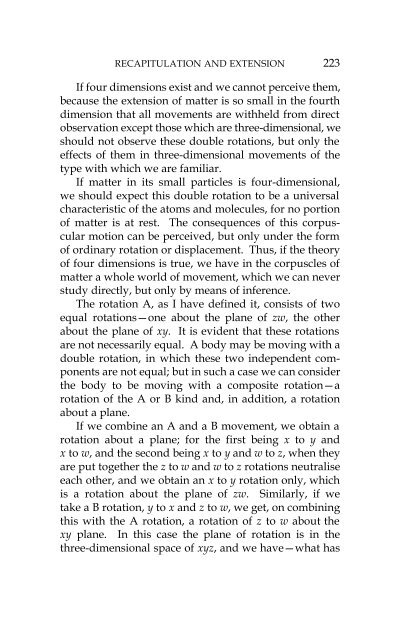Create successful ePaper yourself
Turn your PDF publications into a flip-book with our unique Google optimized e-Paper software.
RECAPITULATION AND EXTENSION 223<br />
If four dimensions exist and we cannot perceive them,<br />
because the extension of matter is so small in the fourth<br />
dimension that all movements are withheld from direct<br />
observation except those which are three-dimensional, we<br />
should not observe these double rotations, but only the<br />
effects of them in three-dimensional movements of the<br />
type with which we are familiar.<br />
If matter in its small particles is four-dimensional,<br />
we should expect this double rotation to be a universal<br />
characteristic of the atoms and molecules, for no portion<br />
of matter is at rest. <strong>The</strong> consequences of this corpuscular<br />
motion can be perceived, but only under the form<br />
of ordinary rotation or displacement. Thus, if the theory<br />
of four dimensions is true, we have in the corpuscles of<br />
matter a whole world of movement, which we can never<br />
study directly, but only by means of inference.<br />
<strong>The</strong> rotation A, as I have defined it, consists of two<br />
equal rotations—one about the plane of zw, the other<br />
about the plane of xy. It is evident that these rotations<br />
are not necessarily equal. A body may be moving with a<br />
double rotation, in which these two independent components<br />
are not equal; but in such a case we can consider<br />
the body to be moving with a composite rotation—a<br />
rotation of the A or B kind and, in addition, a rotation<br />
about a plane.<br />
If we combine an A and a B movement, we obtain a<br />
rotation about a plane; for the first being x to y and<br />
x to w, and the second being x to y and w to z, when they<br />
are put together the z to w and w to z rotations neutralise<br />
each other, and we obtain an x to y rotation only, which<br />
is a rotation about the plane of zw. Similarly, if we<br />
take a B rotation, y to x and z to w, we get, on combining<br />
this with the A rotation, a rotation of z to w about the<br />
xy plane. In this case the plane of rotation is in the<br />
three-dimensional space of xyz, and we have—what has






![[PDF] Prolegomena](https://img.yumpu.com/16774951/1/190x245/pdf-prolegomena.jpg?quality=85)









